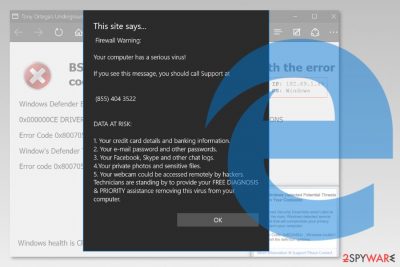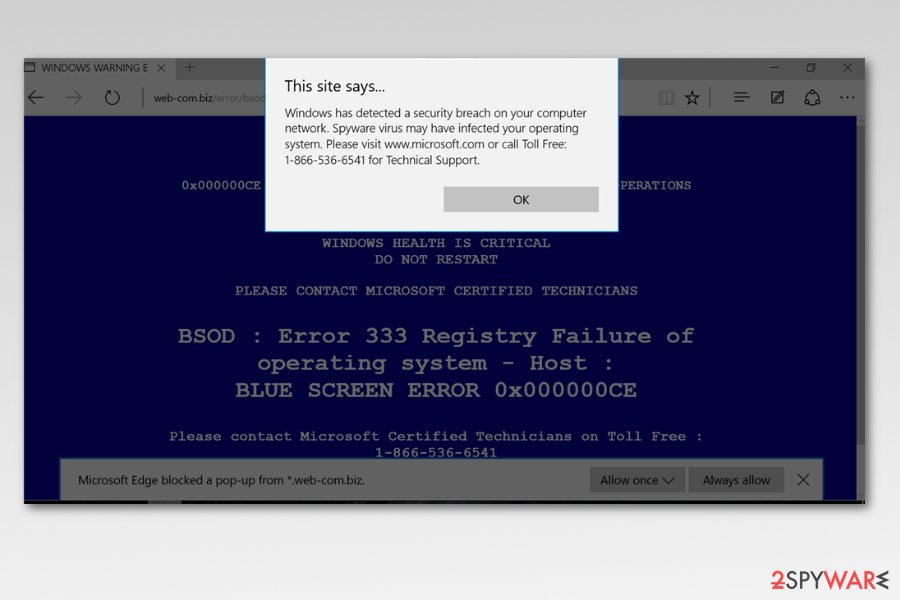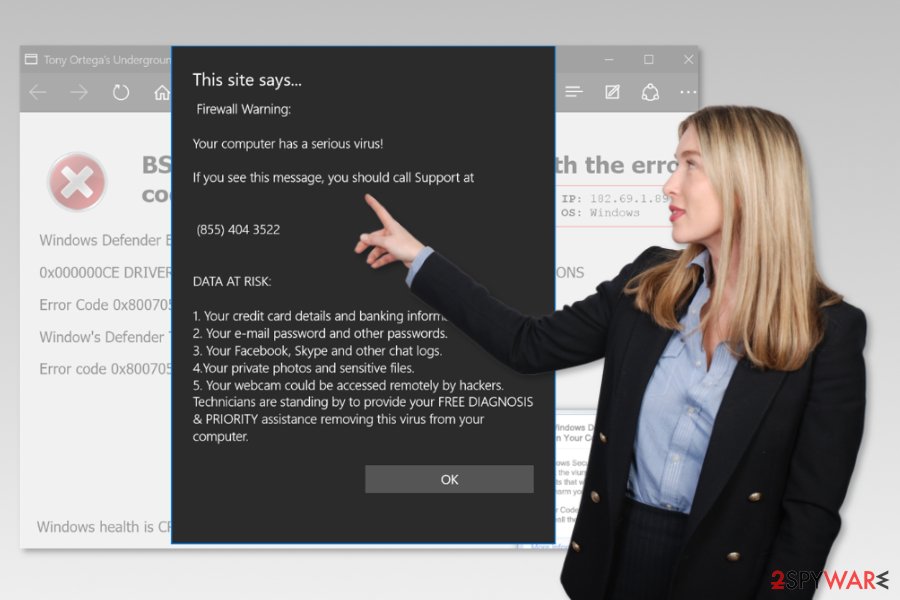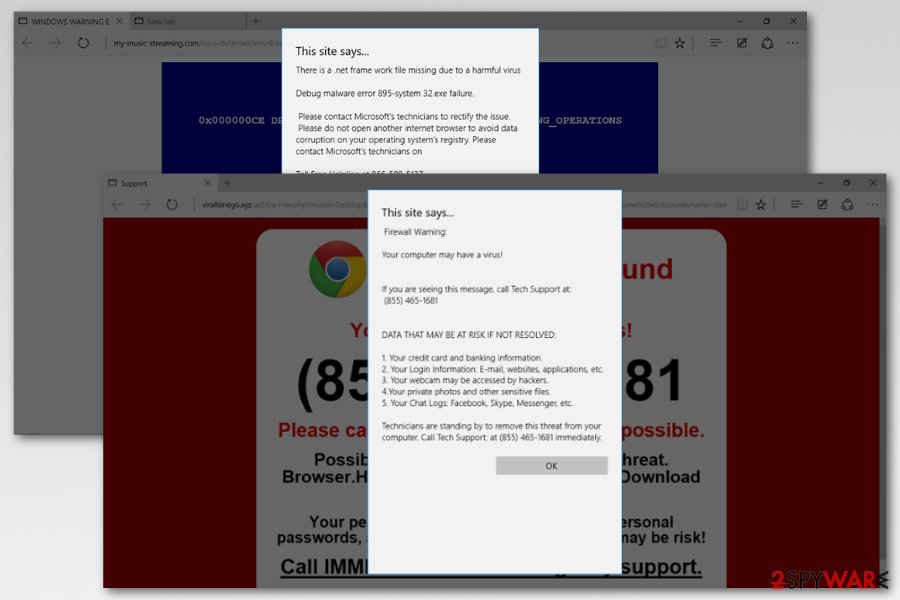Microsoft Edge virus (Free Guide) - 2021 update
Microsoft Edge virus Removal Guide
What is Microsoft Edge virus?
Microsoft Edge virus is a term used to describe scams and malware that abuse this popular Microsoft search tool

Microsoft Edge virus is a term used to describe technical support scams[1] targeting users who have Windows 10 or another OS version installed on their computers. The fake alert can be seen at any time during the web browsing sessions – it claims that users' machines are infected with a virus and that credit card details and other personal information is being leaked by cybercriminals.
As evident, this scam comes from malicious actors who pretend to be working for this tech giant. Users are asked to call (855) 404 3522 or similar phone numbers to solve these “found issues.” However, before you grab your phone and attempt to fix nonexistent issues on your machine, keep in mind that these scammers have nothing to do with Microsoft and only seek your money or remote access to your computer. If not ignored, the scam can lead you to the loss of your personal information or infiltration of malware.
Besides tech support scams, MS Edge can also be abused for other purposes. For example, users who choose this browser can also be redirected to malicious sites by potentially unwanted programs or malware. Besides, Trojans can enable background connections that would slow down the browser significantly, as it would be spammed with endless requests to particular sites. To conclude, Microsoft Edge virus can be related to a variety of malware that needs to be taken care of as soon as possible.
| Name | Microsoft Edge virus |
|---|---|
| Type | Tech support scam |
| Related scams | |
| Main way of functionality | Scam messages bombard its victims with constant warning alerts claiming that their data is at risk and that the only way to protect it is to call the given number |
| Main dangers | After being connected to cybercriminals, you can be tricked into downloading malware, revealing your personal information and paying for non-existent services |
| Virus responsible for this scam | Users start seeing scams and fake warnings after being infected with adware-type programs. Typically, these viruses are spread in a bundle with freeware |
| Elimination & recovery | To get rid of potentially unwanted programs, run SpyHunter 5Combo Cleaner after downloading its latest version. You can use FortectIntego to eliminate post-virus issues, damaged and corrupted files. |
Redirects to fake warning alerts typically occur after the infiltration of adware and another potentially unwanted program (PUP). However, in 2018, some compromised sites have also started showing fake alerts. In this case, you should just ignore the warning message, close the fake window and continue your browsing without visiting affected websites.
The scam not only reports about malware detected on the system. It also delivers some error codes, such as 0x8024402c[2] (it’s a legit Windows Update error that has nothing in common with a scam), and displays a pop-up message:
Firewall Warning:
Your computer has a serious virus!
If you see this message, you should call Support at
(855) 404 3522DATA AT RISK:
1 Your credit card details and banking information.
2. Your e-mail password and other passwords.
3. Your Facebook, Skype and other chat logs.
4.Your private photos and sensitive files.
5. Your webcam could be accessed remotely by hackers.
Technicians are standing by to provide your FREE DIAGNOSIS
& PRIORITY assistance removing this virus from your computer.
However, a technical support scam website also plays an audio file. Yet, the message might not go away. It might show up every time when you open the Edge. Thus, it might replace your default startup page.

In some cases, this cyber threat prevents closing this page and freezes the browser. However, you should still force-quit it and start Microsoft Edge virus removal. Bear in mind that your computer is not infected with a cyber threat that is described in the pop-up alert. Thus, calling the provided number is not needed.
People standing behind the malware might have numerous evil intentions, such as:
- tricking you into obtaining useless security software to clean your PC;
- convincing you to install remote access tools to solve the issue quickly;
- swindling personally identifiable or financial data.
Therefore, calling the fake support phone number might lead to installing a malicious program, money loss, or even identity theft. If you are bothered by this issue, remove the adware virus on your computer which is causing it. Additionally, use FortectIntego to fix corrupted files and similar outcomes caused by the virus.

Chromium-based Edge is privacy-focused and more secure, although can still be abused by threat actors
In January 2020, Microsoft released a brand new MS Edge browser, which is based on Chromium. The new release was a great success, as Microsoft made this browser much more secure and more privacy-focused[3] and went ahead of many of its competitors. As a result, many users decided to leave Chrome, as the latter is known to be gathering a variety of user information during their browsing sessions for profits.
Despite this, the Microsoft Edge virus prevails, even though the improved security measures of the browser can ensure that scams and other malicious websites will be encountered much less commonly. Therefore, even if you chose this brand new browser to perform your daily searches on, watch out for random popups that claim about virus infections or missing Flash Player updates – these messages are all scams and should be ignored.
If you still encountered scam messages on the Chromium-based browser, we recommend you do not ignore it, as it might be infected with adware or even malware. Do not click on anything on such fake sites, close down the tab immediately, and never download anything that is suggested. This way, you will keep your browser and computer secure and malware-free.
Software bundles and shady ads are the main methods used to spread the virus
Adware might spread using the “traditional” PUP distribution method – bundling. It means that the virus might be presented as a toolbar, browser extension, or other legitimate application and included as an optional component in the freeware or shareware bundle.
It’s easy to install PUPs unintentionally, especially if you rely on “Recommended” or rush through the “Advanced” installation guide. It’s important to use only the “Advanced” setup but follow the guide carefully because you have to read all notifications and unmark pre-selected ticks from additional download offers.

Additionally, various cyber threats are hiding in online ads. Security specialists from bedynet.ru[4] warn to stay away from advertisements that offer to download security programs, install updates or inform about detected viruses.
Removal of the Microsoft Edge virus requires restoring web browsers to their primary state
To remove the virus, you need to acquire some special knowledge related to the computer system and web browsers. If you are willing to fix your machine manually, we highly recommend resetting every web browser that you have on your computer. Additionally, you will have to find a special directory on Edge, which can be reached by using a guide below.
However, note that this cyber threat might install suspicious components that are hard to identify and terminate. Thus, security software can save time and help you succeed in virus elimination. Programs that you can choose for Microsoft Edge virus removal are given right below this article.
If you really believe that your Edge browser is infected, use the following steps. Additionally, you should find all suspicious programs, applications, and files on your computer by investigating the system.
- Open Task Manager and go to Processes Tab.
- Find Microsoft Edge process, right-click it and choose End Task option.
- Disable your Internet connection.
- Go to this directory:
C:\Users\YOUR_USERNAME\AppData\Local\Packages\Microsoft.MicrosoftEdge_xxxxxxxxxxxxx\AC\MicrosoftEdge\User\Default\Recovery\Active
NOTE. “xxxxxx” part is different from every user. - Once in this directory, delete the last folder.
You may remove virus damage with a help of FortectIntego. SpyHunter 5Combo Cleaner and Malwarebytes are recommended to detect potentially unwanted programs and viruses with all their files and registry entries that are related to them.
Getting rid of Microsoft Edge virus. Follow these steps
Uninstall from Windows
To uninstall the virus scam and malware-related components that are causing it, you have to look thru the list of recently installed programs and remove suspicious entries. Additionally, you should reset all of your web browsers as well.
Instructions for Windows 10/8 machines:
- Enter Control Panel into Windows search box and hit Enter or click on the search result.
- Under Programs, select Uninstall a program.

- From the list, find the entry of the suspicious program.
- Right-click on the application and select Uninstall.
- If User Account Control shows up, click Yes.
- Wait till uninstallation process is complete and click OK.

If you are Windows 7/XP user, proceed with the following instructions:
- Click on Windows Start > Control Panel located on the right pane (if you are Windows XP user, click on Add/Remove Programs).
- In Control Panel, select Programs > Uninstall a program.

- Pick the unwanted application by clicking on it once.
- At the top, click Uninstall/Change.
- In the confirmation prompt, pick Yes.
- Click OK once the removal process is finished.
Delete from macOS
Remove items from Applications folder:
- From the menu bar, select Go > Applications.
- In the Applications folder, look for all related entries.
- Click on the app and drag it to Trash (or right-click and pick Move to Trash)

To fully remove an unwanted app, you need to access Application Support, LaunchAgents, and LaunchDaemons folders and delete relevant files:
- Select Go > Go to Folder.
- Enter /Library/Application Support and click Go or press Enter.
- In the Application Support folder, look for any dubious entries and then delete them.
- Now enter /Library/LaunchAgents and /Library/LaunchDaemons folders the same way and terminate all the related .plist files.

Remove from Microsoft Edge
Make sure that your Edge browser is not infected with suspicious add-ons or plugins. Additionally, reset the browser to be certain that all scam-related entries are gone for good.
Delete unwanted extensions from MS Edge:
- Select Menu (three horizontal dots at the top-right of the browser window) and pick Extensions.
- From the list, pick the extension and click on the Gear icon.
- Click on Uninstall at the bottom.

Clear cookies and other browser data:
- Click on the Menu (three horizontal dots at the top-right of the browser window) and select Privacy & security.
- Under Clear browsing data, pick Choose what to clear.
- Select everything (apart from passwords, although you might want to include Media licenses as well, if applicable) and click on Clear.

Restore new tab and homepage settings:
- Click the menu icon and choose Settings.
- Then find On startup section.
- Click Disable if you found any suspicious domain.
Reset MS Edge if the above steps did not work:
- Press on Ctrl + Shift + Esc to open Task Manager.
- Click on More details arrow at the bottom of the window.
- Select Details tab.
- Now scroll down and locate every entry with Microsoft Edge name in it. Right-click on each of them and select End Task to stop MS Edge from running.

If this solution failed to help you, you need to use an advanced Edge reset method. Note that you need to backup your data before proceeding.
- Find the following folder on your computer: C:\\Users\\%username%\\AppData\\Local\\Packages\\Microsoft.MicrosoftEdge_8wekyb3d8bbwe.
- Press Ctrl + A on your keyboard to select all folders.
- Right-click on them and pick Delete

- Now right-click on the Start button and pick Windows PowerShell (Admin).
- When the new window opens, copy and paste the following command, and then press Enter:
Get-AppXPackage -AllUsers -Name Microsoft.MicrosoftEdge | Foreach {Add-AppxPackage -DisableDevelopmentMode -Register “$($_.InstallLocation)\\AppXManifest.xml” -Verbose

Instructions for Chromium-based Edge
Delete extensions from MS Edge (Chromium):
- Open Edge and click select Settings > Extensions.
- Delete unwanted extensions by clicking Remove.

Clear cache and site data:
- Click on Menu and go to Settings.
- Select Privacy, search and services.
- Under Clear browsing data, pick Choose what to clear.
- Under Time range, pick All time.
- Select Clear now.

Reset Chromium-based MS Edge:
- Click on Menu and select Settings.
- On the left side, pick Reset settings.
- Select Restore settings to their default values.
- Confirm with Reset.

Remove from Mozilla Firefox (FF)
Remove dangerous extensions:
- Open Mozilla Firefox browser and click on the Menu (three horizontal lines at the top-right of the window).
- Select Add-ons.
- In here, select unwanted plugin and click Remove.

Reset the homepage:
- Click three horizontal lines at the top right corner to open the menu.
- Choose Options.
- Under Home options, enter your preferred site that will open every time you newly open the Mozilla Firefox.
Clear cookies and site data:
- Click Menu and pick Settings.
- Go to Privacy & Security section.
- Scroll down to locate Cookies and Site Data.
- Click on Clear Data…
- Select Cookies and Site Data, as well as Cached Web Content and press Clear.

Reset Mozilla Firefox
If clearing the browser as explained above did not help, reset Mozilla Firefox:
- Open Mozilla Firefox browser and click the Menu.
- Go to Help and then choose Troubleshooting Information.

- Under Give Firefox a tune up section, click on Refresh Firefox…
- Once the pop-up shows up, confirm the action by pressing on Refresh Firefox.

Remove from Google Chrome
To get rid of the scam manually, follow this guide:
Delete malicious extensions from Google Chrome:
- Open Google Chrome, click on the Menu (three vertical dots at the top-right corner) and select More tools > Extensions.
- In the newly opened window, you will see all the installed extensions. Uninstall all the suspicious plugins that might be related to the unwanted program by clicking Remove.

Clear cache and web data from Chrome:
- Click on Menu and pick Settings.
- Under Privacy and security, select Clear browsing data.
- Select Browsing history, Cookies and other site data, as well as Cached images and files.
- Click Clear data.

Change your homepage:
- Click menu and choose Settings.
- Look for a suspicious site in the On startup section.
- Click on Open a specific or set of pages and click on three dots to find the Remove option.
Reset Google Chrome:
If the previous methods did not help you, reset Google Chrome to eliminate all the unwanted components:
- Click on Menu and select Settings.
- In the Settings, scroll down and click Advanced.
- Scroll down and locate Reset and clean up section.
- Now click Restore settings to their original defaults.
- Confirm with Reset settings.

Delete from Safari
Remove unwanted extensions from Safari:
- Click Safari > Preferences…
- In the new window, pick Extensions.
- Select the unwanted extension and select Uninstall.

Clear cookies and other website data from Safari:
- Click Safari > Clear History…
- From the drop-down menu under Clear, pick all history.
- Confirm with Clear History.

Reset Safari if the above-mentioned steps did not help you:
- Click Safari > Preferences…
- Go to Advanced tab.
- Tick the Show Develop menu in menu bar.
- From the menu bar, click Develop, and then select Empty Caches.

After uninstalling this potentially unwanted program (PUP) and fixing each of your web browsers, we recommend you to scan your PC system with a reputable anti-spyware. This will help you to get rid of Microsoft Edge registry traces and will also identify related parasites or possible malware infections on your computer. For that you can use our top-rated malware remover: FortectIntego, SpyHunter 5Combo Cleaner or Malwarebytes.
How to prevent from getting malware
Do not let government spy on you
The government has many issues in regards to tracking users' data and spying on citizens, so you should take this into consideration and learn more about shady information gathering practices. Avoid any unwanted government tracking or spying by going totally anonymous on the internet.
You can choose a different location when you go online and access any material you want without particular content restrictions. You can easily enjoy internet connection without any risks of being hacked by using Private Internet Access VPN.
Control the information that can be accessed by government any other unwanted party and surf online without being spied on. Even if you are not involved in illegal activities or trust your selection of services, platforms, be suspicious for your own security and take precautionary measures by using the VPN service.
Backup files for the later use, in case of the malware attack
Computer users can suffer from data losses due to cyber infections or their own faulty doings. Ransomware can encrypt and hold files hostage, while unforeseen power cuts might cause a loss of important documents. If you have proper up-to-date backups, you can easily recover after such an incident and get back to work. It is also equally important to update backups on a regular basis so that the newest information remains intact – you can set this process to be performed automatically.
When you have the previous version of every important document or project you can avoid frustration and breakdowns. It comes in handy when malware strikes out of nowhere. Use Data Recovery Pro for the data restoration process.
- ^ Protect yourself from tech support scams. Microsoft. The official support website.
- ^ Linas Kiguolis. How to Fix Windows Update Error Code 0x8024402c?. Ugetfix. How to fix a computer.
- ^ Aliya Chaudhry. How to use Edge’s tools to protect your privacy while browsing. The Verge. American technology news website.
- ^ Bedynet. Bedynet. Latest cyber security news.























